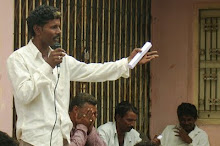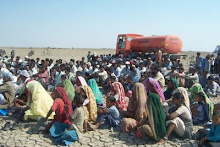Counterview: Ahmedabad: Wednesday, 7 Feb 2024.
If you visit Kharaghoda, Zinzuwada or Halvad Rann, or even Santalpur Rann areas in the Little Rann of Kutch these days, you will be surprised to see Narmada waters are flowing in the Rann areas, which are otherwise supposed to be a dry desert for eight months of a year.
The Narmada waters are continuously flowing in these areas for the last two plus months, spreading to up to as far as 40 km inside, inundating widespread areas of the Rann.
From where are the waters released and how are they reaching the Rann?
The Rann is triangular shaped, spread over approximately 5,000 sq km area, and lies between Surendranagar (Patadi, Dhangadhra block), Morbi (Halvad, Maliya block), Patan (Santalpur block) and Kutch (Rapar block) districts.
Many rivers like Rupen, Banas and small-big streams in these districts meet the Rann, and during the rainy season, they carry rainwater into the Rann. Waters also come in from the Surajbari creek, turning the Rann into a brackish water lake for 3-4 months. However, by September, the waters dry up, and flow back into the creek, and cracked mud-flats emerge, making into into a mud desert for the rest of the period.
The Narmada waters are released in large quantity in these rivers and streams for the purpose of irrigation, but they reach the Rann areas, thus get wasted. This happens mostly December onwards.
Impact on salt farms
Gujarat produces 76% of India’s total salt production, and the Rann contributes 31% of it. Large scale water released from the Narmada canal during the salt season makes severe impact on the salt farming inside the Rann. Salt farms are inundated, and the density of the brine reduces when the Narmada waters get mixed with the brine in the salt farms.
Sometimes bunds constructed by saltpan farmers are washed away by these waters. The salt farmers', or Agariyas', access to their well and farm (Agar) gets restricted, thereby affecting salt production.
Worse, once the Rann is flooded with Narmada waters, water tankers and mobile health vans cannot reach the Agariyas, depriving them of health service and drinking water supply.
In fact, floods in Rann due to Narmada waters are a recurring incident and this has been going on for the past several years.
In 2017, the sudden release of waters in Banas river led to huge floods and the Agariyas had to immediately rush back to their villages from salt farms. One pregnant Agariya women died as she got labour pain and could not reached hospital on time.
“Narmada waters are released in large quantity in rivers and streams for irrigation, but they reach the Rann areas, thus get wasted.”
In 2021, Kharagodha and Zinzuwada were flooded with Narmada waters, and 159 salt farms were destroyed. A committee headed by the director (civil) Sardar Sarovar Narmada Nigam (SSNNL) visited the Rann and met Agariyas for analyzing the situation and filed a report. Damage assessment was done but no compensation was given.
Impact on wild life and biodiversity
The Rann is the Wild Ass Sanctuary, and such frequent floods with Narmada waters are bound to affect the rare species' habitat, apart having adverse impact on the biodiversity of the Rann.
The wild ass requires a dry desert environment, and it can't reside in wetlands. It walks, wanders and runs in the dry mudflats of the wild ass sanctuary. More than 6,000 wild asses are conserved here.
Inundation of the desert during winter and summer restricts the movement of the wild ass, which may have long-term impact on its habitation and growth. Additionally, the Rann has many species like spiders which make rare nets in the mud-flat cracks, and reptiles stay in underground holes. All of this may also get affected.
One wonders:
If you visit Kharaghoda, Zinzuwada or Halvad Rann, or even Santalpur Rann areas in the Little Rann of Kutch these days, you will be surprised to see Narmada waters are flowing in the Rann areas, which are otherwise supposed to be a dry desert for eight months of a year.
The Narmada waters are continuously flowing in these areas for the last two plus months, spreading to up to as far as 40 km inside, inundating widespread areas of the Rann.
From where are the waters released and how are they reaching the Rann?
The Rann is triangular shaped, spread over approximately 5,000 sq km area, and lies between Surendranagar (Patadi, Dhangadhra block), Morbi (Halvad, Maliya block), Patan (Santalpur block) and Kutch (Rapar block) districts.
Many rivers like Rupen, Banas and small-big streams in these districts meet the Rann, and during the rainy season, they carry rainwater into the Rann. Waters also come in from the Surajbari creek, turning the Rann into a brackish water lake for 3-4 months. However, by September, the waters dry up, and flow back into the creek, and cracked mud-flats emerge, making into into a mud desert for the rest of the period.
The Narmada waters are released in large quantity in these rivers and streams for the purpose of irrigation, but they reach the Rann areas, thus get wasted. This happens mostly December onwards.
Impact on salt farms
Gujarat produces 76% of India’s total salt production, and the Rann contributes 31% of it. Large scale water released from the Narmada canal during the salt season makes severe impact on the salt farming inside the Rann. Salt farms are inundated, and the density of the brine reduces when the Narmada waters get mixed with the brine in the salt farms.
Sometimes bunds constructed by saltpan farmers are washed away by these waters. The salt farmers', or Agariyas', access to their well and farm (Agar) gets restricted, thereby affecting salt production.
Worse, once the Rann is flooded with Narmada waters, water tankers and mobile health vans cannot reach the Agariyas, depriving them of health service and drinking water supply.
In fact, floods in Rann due to Narmada waters are a recurring incident and this has been going on for the past several years.
In 2017, the sudden release of waters in Banas river led to huge floods and the Agariyas had to immediately rush back to their villages from salt farms. One pregnant Agariya women died as she got labour pain and could not reached hospital on time.
“Narmada waters are released in large quantity in rivers and streams for irrigation, but they reach the Rann areas, thus get wasted.”
In 2021, Kharagodha and Zinzuwada were flooded with Narmada waters, and 159 salt farms were destroyed. A committee headed by the director (civil) Sardar Sarovar Narmada Nigam (SSNNL) visited the Rann and met Agariyas for analyzing the situation and filed a report. Damage assessment was done but no compensation was given.
Impact on wild life and biodiversity
The Rann is the Wild Ass Sanctuary, and such frequent floods with Narmada waters are bound to affect the rare species' habitat, apart having adverse impact on the biodiversity of the Rann.
The wild ass requires a dry desert environment, and it can't reside in wetlands. It walks, wanders and runs in the dry mudflats of the wild ass sanctuary. More than 6,000 wild asses are conserved here.
Inundation of the desert during winter and summer restricts the movement of the wild ass, which may have long-term impact on its habitation and growth. Additionally, the Rann has many species like spiders which make rare nets in the mud-flat cracks, and reptiles stay in underground holes. All of this may also get affected.
One wonders:
- What is the reason for releasing Narmada waters in Banas and Rupen rivers?
- Has the SSNNL estimated the water requirements of the farmers on the periphery of the Rann in order to release reasonable amount of water?
- What is the planning by the SSNNL for storing extra waters that are not used by farmers?
- Who is responsible for such a huge loss of Narmada waters?
- Who will give compensation for the livelihood loss of the Agariyas?

















.jpg)
.jpg)
.jpg)
.jpg)













No comments:
Post a Comment